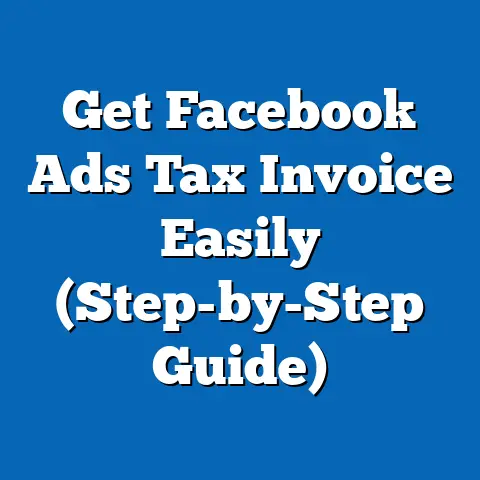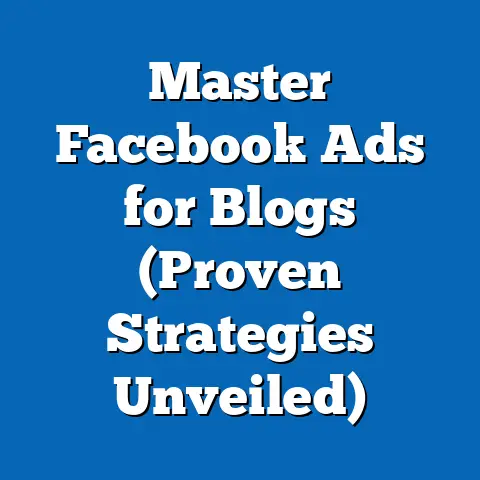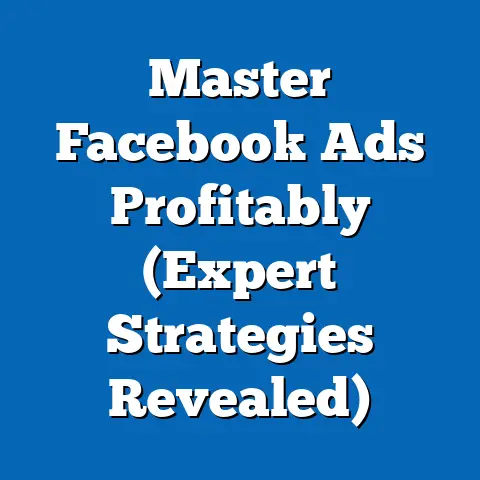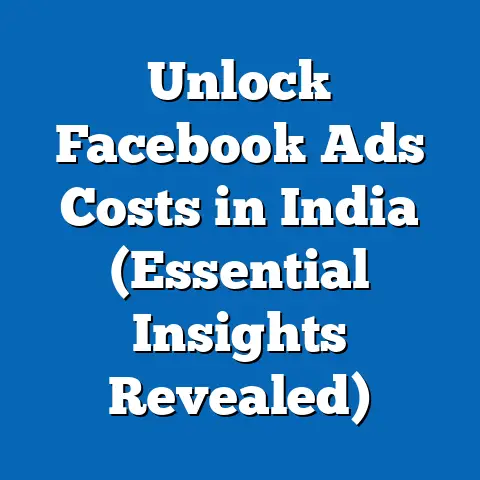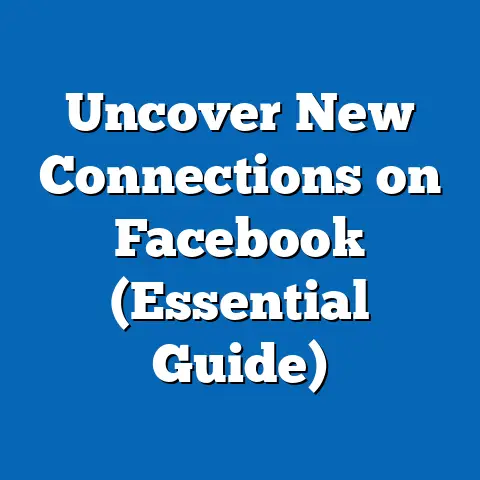Transform Facebook Dynamic Ads (Unlock Higher Conversions)
Transform Facebook Dynamic Ads: Unlock Higher Conversions
Introduction: Flooring as Art
As someone deeply involved in digital marketing and advertising, I’ve always been fascinated by the intersection of creativity and data. It’s a bit like being an artist with a canvas made of algorithms and pixels. And when I think about spaces that truly embody this blend of art and functionality, flooring immediately comes to mind.
Think about it: flooring isn’t just a surface you walk on. It’s the foundation of a room’s aesthetic, setting the tone and mood. The texture of a hardwood floor, the vibrant patterns of a Moroccan tile, the sleekness of polished concrete – each choice evokes a different emotion and transforms the space. Just like a painting, flooring can tell a story, express a style, and ultimately, impact how we experience a room.
Now, what does this have to do with Facebook Dynamic Ads? Well, I believe creating effective Facebook Dynamic Ads is also an art form. It requires creativity to design visuals and craft compelling copy, an understanding of your audience to target the right people, and strategic planning to achieve your desired results – higher conversions. Just as a well-chosen floor can elevate a room, a well-crafted Dynamic Ad can elevate your business.
In this article, I want to share my experiences and insights on how to transform your Facebook Dynamic Ads into powerful conversion tools. We’ll explore the key elements that make them work, the best practices for optimizing your campaigns, and how to leverage data to unlock higher conversion rates. Get ready to unleash your inner artist and transform your Facebook Dynamic Ads into masterpieces that drive real results!
Section 1: Understanding Facebook Dynamic Ads
Before we dive into the artistry, let’s make sure we have a solid understanding of the canvas we’re working with. What exactly are Facebook Dynamic Ads, and why are they so important in today’s digital marketing landscape?
Dynamic Ads are essentially automated product ads that are tailored to individual user behavior and preferences on Facebook. Unlike traditional ads, which require manual creation and targeting, Dynamic Ads use a product catalog and Facebook’s powerful algorithms to automatically show the most relevant products to each user.
How They Work:
- Product Catalog: You upload your entire product inventory to Facebook in a structured format (usually a CSV or XML file). This catalog contains all the information about your products, including images, descriptions, prices, and availability.
- Facebook Pixel: The Facebook Pixel is a piece of code that you install on your website. It tracks user actions, such as viewing products, adding items to their cart, or making a purchase.
- Dynamic Retargeting: When someone interacts with your website, the Facebook Pixel collects data about their behavior. This data is then used to show them Dynamic Ads featuring the products they viewed or added to their cart.
- Automated Personalization: Facebook’s algorithms analyze user behavior and product catalog data to automatically personalize the ads shown to each user. This means that each person sees ads featuring the products they are most likely to be interested in.
Why They’re Important:
In a world where consumers are bombarded with advertising messages, personalization is key to cutting through the noise and capturing their attention. Dynamic Ads leverage this concept to enhance user experience by showing people relevant products they are already interested in. This not only increases the likelihood of a conversion but also improves brand perception by demonstrating that you understand their needs and preferences.
From my personal experience, I’ve seen businesses achieve remarkable results with Dynamic Ads. For instance, I worked with a clothing retailer who was struggling to drive sales on their website. After implementing Dynamic Ads, they saw a 3x increase in conversion rates and a significant boost in revenue. The key was showing users the exact items they had been browsing on the website, reminding them of their interest and encouraging them to complete the purchase.
Takeaway: Facebook Dynamic Ads are automated, personalized product ads that are tailored to individual user behavior. They are essential for enhancing user experience and driving conversions in today’s competitive digital landscape.
Section 2: The Art of Crafting Engaging Dynamic Ads
Now that we understand the basics of Dynamic Ads, let’s explore the art of crafting ads that capture attention, engage users, and ultimately, drive conversions.
A successful Dynamic Ad is more than just a product image and a price tag. It’s a carefully crafted message that resonates with your target audience and motivates them to take action. Here are the key components:
1. Compelling Visuals:
High-quality images and videos are essential for capturing attention and showcasing your products in the best possible light. Use professional-grade photography or videography to highlight the features and benefits of your products.
- Tips:
- Use lifestyle images that show your products in use.
- Experiment with different angles, lighting, and backgrounds.
- Ensure your images are optimized for mobile devices.
- Use lifestyle images that show your products in use.
- Experiment with different angles, lighting, and backgrounds.
- Ensure your images are optimized for mobile devices.
2. Persuasive Copy:
Your ad copy should be concise, engaging, and persuasive. Highlight the key benefits of your products and address any potential concerns or objections.
- Tips:
- Use strong action verbs and compelling language.
- Personalize your message to resonate with your target audience.
- Include social proof, such as customer testimonials or reviews.
- Use strong action verbs and compelling language.
- Personalize your message to resonate with your target audience.
- Include social proof, such as customer testimonials or reviews.
3. Clear Call to Action (CTA):
A clear and compelling CTA tells users exactly what you want them to do next. Use action-oriented language that encourages them to click, shop, or learn more.
- Tips:
- Use contrasting colors to make your CTA button stand out.
- Test different CTA options to see which performs best.
- Ensure your CTA is relevant to the product and the user’s stage in the buying process.
- Use contrasting colors to make your CTA button stand out.
- Test different CTA options to see which performs best.
- Ensure your CTA is relevant to the product and the user’s stage in the buying process.
A/B Testing:
One of the most important aspects of crafting engaging Dynamic Ads is A/B testing different ad creatives. This involves creating multiple versions of your ads with variations in visuals, copy, and CTAs, and then testing them against each other to see which performs best.
- Tips:
- Test one element at a time to isolate the impact of each change.
- Use Facebook’s built-in A/B testing tools to track performance.
- Continuously iterate and refine your ad creatives based on the results of your A/B tests.
- Test one element at a time to isolate the impact of each change.
- Use Facebook’s built-in A/B testing tools to track performance.
- Continuously iterate and refine your ad creatives based on the results of your A/B tests.
In my experience, A/B testing can make a huge difference in the performance of your Dynamic Ads. For example, I worked with a furniture retailer who was struggling to get clicks on their ads. After A/B testing different headlines, they discovered that using questions in their headlines significantly increased click-through rates. This simple change led to a substantial improvement in their overall ad performance.
Takeaway: Crafting engaging Dynamic Ads requires a blend of creativity, strategic thinking, and data-driven optimization. Use compelling visuals, persuasive copy, and clear CTAs to capture attention and drive conversions. And don’t forget to A/B test different ad creatives to see what resonates best with your target audience.
Section 3: Targeting the Right Audience
Even the most beautifully crafted Dynamic Ad will fall flat if it’s not shown to the right people. That’s why audience segmentation and targeting are so crucial for the success of your Dynamic Ad campaigns.
Facebook offers a wide range of targeting options to help you reach your ideal customers, including:
1. Custom Audiences:
Custom Audiences allow you to target people who have already interacted with your business, either online or offline. You can create Custom Audiences based on:
- Website Traffic: People who have visited your website or specific pages on your website.
- Customer Lists: People who are in your customer database, such as email subscribers or past purchasers.
- App Activity: People who have used your mobile app.
- Offline Activity: People who have interacted with your business in the real world, such as visiting your store or attending an event.
2. Lookalike Audiences:
Lookalike Audiences allow you to target people who are similar to your existing customers. Facebook analyzes the characteristics of your Custom Audiences and identifies other users who share those same traits.
- Tips:
- Start with your best-performing Custom Audience as the seed for your Lookalike Audience.
- Experiment with different Lookalike Audience sizes to find the optimal balance between reach and relevance.
- Continuously monitor the performance of your Lookalike Audiences and refine your targeting as needed.
- Start with your best-performing Custom Audience as the seed for your Lookalike Audience.
- Experiment with different Lookalike Audience sizes to find the optimal balance between reach and relevance.
- Continuously monitor the performance of your Lookalike Audiences and refine your targeting as needed.
3. Interest-Based Targeting:
Interest-Based Targeting allows you to target people based on their interests, hobbies, and passions. Facebook gathers this information from user profiles, page likes, and other online activity.
- Tips:
- Research your target audience to identify their key interests.
- Use Facebook’s Audience Insights tool to discover new and relevant interests.
- Combine Interest-Based Targeting with other targeting options for more precise results.
- Research your target audience to identify their key interests.
- Use Facebook’s Audience Insights tool to discover new and relevant interests.
- Combine Interest-Based Targeting with other targeting options for more precise results.
Analyzing Audience Behavior:
To optimize your audience targeting, it’s essential to analyze audience behavior and preferences. Facebook provides a wealth of data on your audience, including demographics, interests, and behaviors.
- Tips:
- Use Facebook Analytics to track audience engagement and conversions.
- Monitor the performance of your different targeting options to see which is driving the best results.
- Continuously refine your audience targeting based on your data insights.
- Use Facebook Analytics to track audience engagement and conversions.
- Monitor the performance of your different targeting options to see which is driving the best results.
- Continuously refine your audience targeting based on your data insights.
I once worked with a travel agency who was struggling to reach their target audience on Facebook. After analyzing their audience data, we discovered that their ideal customers were not only interested in travel but also in specific activities, such as hiking, skiing, and scuba diving. By incorporating these interests into their targeting, they were able to significantly improve the performance of their Dynamic Ad campaigns.
Takeaway: Targeting the right audience is crucial for the success of your Dynamic Ad campaigns. Use Custom Audiences, Lookalike Audiences, and Interest-Based Targeting to reach your ideal customers. And don’t forget to analyze audience behavior and preferences to optimize your targeting for better performance.
Section 4: Leveraging Data for Improved Performance
Data is the lifeblood of any successful marketing campaign, and Facebook Dynamic Ads are no exception. By leveraging data from Facebook Analytics and the Facebook Pixel, you can gain valuable insights into your audience, your ad performance, and your overall ROI.
Facebook Analytics:
Facebook Analytics provides a comprehensive view of your audience’s behavior across your website, your mobile app, and your Facebook Page. You can use it to track key metrics, such as:
- Website Traffic: The number of visitors to your website, the pages they visit, and the amount of time they spend on each page.
- Conversions: The number of people who complete a desired action on your website, such as making a purchase, filling out a form, or subscribing to your newsletter.
- Engagement: The number of people who interact with your content, such as liking, commenting, or sharing your posts.
- Demographics: The age, gender, location, and interests of your audience.
Facebook Pixel:
The Facebook Pixel tracks user actions on your website and sends that data back to Facebook. This data is used to:
- Retarget Website Visitors: Show Dynamic Ads to people who have visited your website or specific pages on your website.
- Optimize for Conversions: Optimize your ad campaigns to target people who are most likely to convert.
- Track Conversions: Measure the effectiveness of your ad campaigns by tracking the number of conversions that result from your ads.
Tracking Conversions, Engagement, and ROI:
To measure the success of your Dynamic Ad campaigns, it’s essential to track key metrics, such as:
- Conversion Rate: The percentage of people who click on your ad and then complete a desired action on your website.
- Click-Through Rate (CTR): The percentage of people who see your ad and then click on it.
- Cost Per Acquisition (CPA): The average cost of acquiring a new customer through your ad campaigns.
- Return on Ad Spend (ROAS): The amount of revenue you generate for every dollar you spend on advertising.
Interpreting Data Insights:
Once you’ve collected data from Facebook Analytics and the Facebook Pixel, it’s time to interpret those insights and use them to refine your ad strategies.
- Identify High-Performing Products: Which products are driving the most conversions? Focus your ad spend on those products.
- Optimize Audience Targeting: Which targeting options are driving the best results? Refine your targeting to focus on those audiences.
- Improve Ad Creatives: Which ad creatives are generating the highest CTR and conversion rates? Use those creatives as a template for future ads.
I remember working with an e-commerce business that was struggling to understand the performance of their Dynamic Ad campaigns. After analyzing their data, we discovered that a significant portion of their ad spend was being wasted on targeting people who were not interested in their products. By refining their audience targeting and focusing on high-performing products, they were able to significantly improve their ROAS.
Takeaway: Data is essential for improving the performance of your Dynamic Ad campaigns. Use Facebook Analytics and the Facebook Pixel to track key metrics, interpret data insights, and refine your ad strategies for better results.
Section 5: Enhancing User Experience through Retargeting
Retargeting is a powerful technique that allows you to re-engage users who have previously interacted with your brand. In the context of Facebook Dynamic Ads, retargeting involves showing Dynamic Ads to people who have visited your website, viewed your products, or added items to their cart.
Why Retargeting Works:
Retargeting works because it reminds people of their interest in your products and encourages them to complete the purchase. People who have already interacted with your brand are more likely to convert than people who are seeing your ads for the first time.
How to Implement Retargeting:
- Install the Facebook Pixel: Make sure the Facebook Pixel is installed on your website and tracking user actions.
- Create Custom Audiences: Create Custom Audiences based on website traffic, product views, and cart abandonment.
- Create Retargeting Campaigns: Create Dynamic Ad campaigns that target your Custom Audiences.
- Personalize Your Ads: Personalize your ads to show people the specific products they viewed or added to their cart.
Case Studies:
I’ve seen countless examples of successful retargeting campaigns that led to significant increases in conversions. Here are a couple of examples:
- E-Commerce Business: An e-commerce business saw a 2x increase in conversion rates after implementing retargeting campaigns that showed users the specific products they had abandoned in their cart.
- Travel Agency: A travel agency saw a 3x increase in bookings after implementing retargeting campaigns that showed users the specific destinations they had been browsing on their website.
Takeaway: Retargeting is a powerful technique for enhancing user experience and driving conversions. By re-engaging users who have previously interacted with your brand, you can significantly increase the likelihood of a purchase.
Section 6: Best Practices for Dynamic Ads
To wrap things up, here’s a list of best practices for creating effective Dynamic Ads:
- Optimize for Mobile Devices: Ensure your ads are optimized for mobile devices, as the majority of Facebook users access the platform on their smartphones.
- Use Clear and Concise Messaging: Use clear and concise messaging that highlights the key benefits of your products.
- Ensure Brand Consistency: Maintain brand consistency in your visuals, copy, and tone of voice.
- Use High-Quality Images and Videos: Use high-quality images and videos that showcase your products in the best possible light.
- Personalize Your Ads: Personalize your ads to show people the specific products they viewed or added to their cart.
- Test Different Ad Creatives: A/B test different ad creatives to see which performs best.
- Target the Right Audience: Use Custom Audiences, Lookalike Audiences, and Interest-Based Targeting to reach your ideal customers.
- Track Your Results: Track your results using Facebook Analytics and the Facebook Pixel.
- Refine Your Strategies: Continuously refine your strategies based on your data insights.
- Comply with Facebook’s Advertising Policies: Ensure your ads comply with Facebook’s advertising policies and guidelines.
Seasonal Promotions and Limited-Time Offers:
Don’t forget to leverage seasonal promotions and limited-time offers to drive urgency and conversions. Create Dynamic Ads that highlight special deals and discounts during holidays and other key shopping periods.
Takeaway: By following these best practices, you can create Dynamic Ads that capture attention, engage users, and drive conversions.
Conclusion: Unlocking Higher Conversions through Innovation
Transforming Facebook Dynamic Ads into powerful conversion tools requires a blend of creativity, strategic targeting, and data-driven insights. It’s about understanding your audience, crafting compelling messages, and continuously optimizing your campaigns for better performance.
I encourage you to view your advertising efforts as an art form, where experimentation and innovation can lead to remarkable results. Don’t be afraid to try new things, test different approaches, and push the boundaries of what’s possible.
By embracing this mindset, you can unlock higher conversions and achieve your business goals through the artistic transformation of your Facebook Dynamic Ads. The potential is there, waiting to be unleashed. So, go out there and create some masterpieces!


